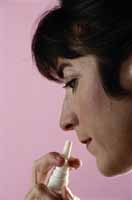Do you wake up every morning sneezing your nose away?
Do you feel that you are only breathing through one nostril instead of both?
Does your runny-nose or nose-block come back after you stop using nasal decongestant spray?
If your answer is “yes” in any of the questions above, perhaps you would want to find out why.
Nasal discharge, a.k.a rhinorrhea, “nose drip” or “runny nose” is a symptom that everybody would experience when one falls sick or cries; so does a nose-block, a common complaint. These two frequently occur together. However, when any of these happens too frequently or too long, for example, every day or more than 4 weeks, perhaps it is not just a common flu. You might want to go to the doctor for a check-up. There are many common causes of chronic rhinitis, or nasal discharge and nasal obstruction which we will discuss about.
Allergy Rhinitis
This is condition due to hypersensitivity to certain allergens that results in inflammation of the mucosal lining. There are two types of allergy rhinitis, i.e. seasonal and perennial.
 Seasonal allergy rhinitis refers to people who experience the symptoms only during certain seasons. This type of allergy rhinitis usually occurs in seasonal countries and especially during the spring season, where flowers blossoms and pollens are ubiquitous in the air. The patient would sneeze from time to time during the season and the nose will be itchy and runny especially when he or she is outdoors, exposed to the flora. This phenomenon can last for several weeks, disappear, and then recur during the same time in the following year. Aside from anti-histamines like loratidine, patients can benefit from prophylaxis such as montelukast sodium or cromoglycates to prevent such attacks before the arrival of the season in order to be able to enjoy the beautiful spring.
Seasonal allergy rhinitis refers to people who experience the symptoms only during certain seasons. This type of allergy rhinitis usually occurs in seasonal countries and especially during the spring season, where flowers blossoms and pollens are ubiquitous in the air. The patient would sneeze from time to time during the season and the nose will be itchy and runny especially when he or she is outdoors, exposed to the flora. This phenomenon can last for several weeks, disappear, and then recur during the same time in the following year. Aside from anti-histamines like loratidine, patients can benefit from prophylaxis such as montelukast sodium or cromoglycates to prevent such attacks before the arrival of the season in order to be able to enjoy the beautiful spring.
Perennial allergy rhinitis is a type that occurs any time throughout the year. Usually due to a particular allergen, be it dust or animal fur, or eating peanut or egg, the patient will experience similar attack like those having seasonal allergy rhinitis. Hence it is important to identify

what is the cause that triggers the allergy attack, and this can be done through tests such as the skin-prick test. Many of such patients have the onset of such problem before the age of 20 and a positive family history of the same condition, eczema or asthma. The best treatment for such patient is the avoidance of the trigger once it is known. Anti-histamine is also the main treatment to control the allergic symptoms.
Vasomotor Rhinitis
This is a neurovascular disorder of the nasal parasympathetic system which affects the mucosal blood vessel in the nose. In other words, it is a non-specific reflex hypersensitivity of the nasal mucosa. Unlike the allergy rhinitis conditions mentioned above, the trigger of vasomotor rhinitis varies. This can include temperature change, hormonal changes such as during pregnancy or menopause, stress and anxiety. It is not an allergy nor is it an infection.
Patients with such condition often presents with complaints of blocked nose which could alternate between both nostrils and also rhinorrhea with thin and watery mucus. These are due to the reflex reaction of the parasympathetic system causing increase nasal blood flow and secretion. Thus, medications that oppose the effect of the parasympathetic activity such as ipratropium bromide – a type of anti-cholinergic, or oxymetazolines – a type of vasoconstrictor, are suitable for patients with this condition. Steroid nasal sprays are also beneficial in order to reduce the inflammation of the nasal cavity.
Rhinitis Medicamentosa
Otherwise known as rebound or chemical rhinitis, this type of rhinitis is caused by prolonged usage of topical nasal decongestants or the “snifflersâ€.  The definite pathophysiology of rhinitis medicamentosa is unknown. However, it is hypothesized that exogenous causes of vasoconstriction results in dysregulation of the parasympathetic and sympathetic system. Most decongestants contain sympathomimetic substances that cause blood vessels to constricts, i.e. vasoconstrictors, e.g. oxymetazoline and phenylephrine. Hence, the proposed mechanism states that prolonged use of such chemicals disrupts the natural balance of the parasympathetic/sympathetic function in the body, resulting in reduced production of the sympathetic hormones and increase activity of the parasympathetic activity when the medication is stopped, thus creating the phenomenon of “rebound†congestion. In a way, it is like an addiction to topical nasal decongestant.
Clinically, in some patients, nose-bl0ck is a more significant symptom than rhinitis in this condition. Nonetheless, nasal obstruction and discharge overlap as usual. It is important to distinguish rhinitis medicamentosa from the other causes of rhinitis so that optimal treatment can be given. Once the diagnosis is established, patients are advised to discontinue usage of the nasal decongestant. If possible, immediately, otherwise, in cases where patient cannot tolerate the immediate cessation, tapering of the decongestant dosage is monitored. Short-term nasal corticosteroid spray is replaced to reduce the inflammation of the mucosal lining in the nasal cavity.
